 |
| |
|
|
| |
Red Tides
|
Harmful Algal Blooms |
|
Algal blooms occur when environmental conditions allow explosive growth of phytoplankton. Very dense blooms can change the color of ocean water, leading to red (or brown, or orange) tides. In California, red tides generally occur in the fall.
Some red tides in California are harmless, while others may contain toxins or be detrimental in other ways. Discoloration of the water alone is not an accurate way to determine whether harmful conditions are present.
Click on images to enlarge. |
|
There are a number of ways in which algal blooms can have a negative impact and be considered harmful. Some phytoplankton species produce toxins, which can affect humans, fish, marine mammals and seabirds. Some species cause fish kills by clogging or lacerating fish gills. Still others negatively impact the system indirectly; by depleting oxygen, blocking sunlight, or interfearing with the waterproofing of seabird feathers.
Click here for a list of toxin-producing phytoplankton.
Click on images to enlarge. |

Lingulodinium bloom, photographed from a small plane. Photo credit E Kisfaludy. |

Whale swimming in Lingulodinium bloom, photographed from a small plane. Photo credit E Kisfaludy. |
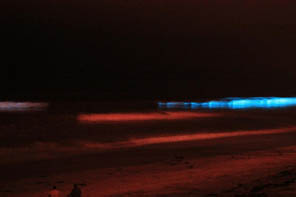
Dinoflagellate bloom at night. Many dinoflagellates are bioluminescent. |

Dinoflagellate bloom at night. |

A dense Noctiluca bloom in Monterey Bay, California. May 2011. |

Akashiwo sanguinea bloom, Monterey Bay, October 2010. |

Bloom seen near Devil's Slide, south of San Francisco, in October 2012. Likely Noctiluca scintillans. Photo credit J. Christiansen. |

Red tide seen near Fort Bragg, CA, October 7, 2011. Photo credit B. Johnson. |
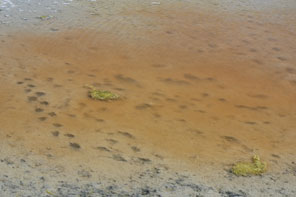
Alexandrium catenella bloom in the Don Edwards Wildlife Refuge, Fremont, CA. Photo credit W. Gurkse. |
| Do you have Harmful Algal Bloom or Red Tide photos that you would like to contribute to this page? Email us at kudelalab@gmail.com |
|

A bloom of Alexandrium in the San Lorenzo River, Santa Cruz, CA. October 2015. |
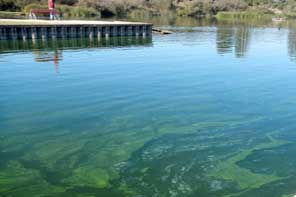
A dense bloom of microcystis in Pinto Lake, Watsonville, CA. |

The yellow staining on the feathers of this Pacific Loon was caused by a non-toxic Akashiwo bloom. Foam produced by the bloom stripped feathers of their waterproof coating. |

Bloom of the toxin-producing dinoflagellate Gonyaulax, off of the Sonoma coast. June 2012. Photo credit J. Herum. |

Abalone and gumboot chitons killed by bloom of Gonyaulax (above). Photo credit N. Buck. |

Toxic Akashiwo bloom in Case Inlet, Puget Sound. Photo credit EOPS, July 31. |

Toxic Akashiwo bloom in Sinclair Inlet, Puget Sound. Photo credit EOPS, July 31. |
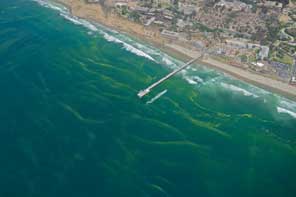
Dense, green bloom of Tetraselmis spp., a prasinophyte, during August 2012 at Scripps Pier, La Jolla, CA. This bloom has been an annual occurrence since 2010. Photo credit E. Kisfaludy. |

Dolphins swimming through a dense bloom of Tetraselmis off San Diego, CA. Photo credit C.J. Smith. |

Dense, green bloom of Tetraselmis spp. during August 2010, San Diego, CA. Photo credit C. J. Smith. |
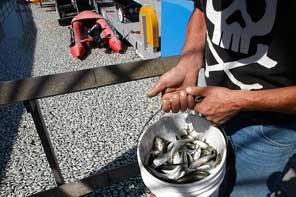
King's Harbor in Redondo Beach, March 2011. Millions of dead fish, cause unknown. Photo credit E. Seubert. |

Ulva bloom on Sand City Beach in Monterey Bay, CA, July 2014. Photo credit Andrew DeVogelaere.
|

Ulva bloom on Sand City Beach in Monterey Bay, CA, July 2014. Photo credit Jamie MacMahan. |

Gonyaulax bloom near Anacortes, WA, July 2014. Photo credit Kevin Bright. |
|
| |
|























